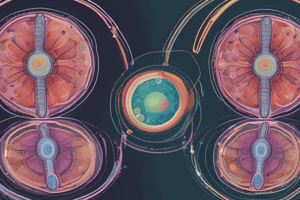Podcast
Questions and Answers
Where does the process of generating energy from glucose in the absence of oxygen occur?
Where does the process of generating energy from glucose in the absence of oxygen occur?
- Cytoplasm (correct)
- Thylakoid membranes
- Stroma of chloroplasts
- Mitochondria
What is the overall equation for photosynthesis?
What is the overall equation for photosynthesis?
- 6 CO2 + 6 H2O + ATP → C6H12O6 (glucose) + 6 O2
- 6 CO2 + 6 H2O → C6H12O6 (glucose)
- 6 CO2 + 6 H2O + light energy → C6H12O6 (glucose) + 6 O2 (correct)
- 6 CO2 + 6 H2O → C6H12O6 (glucose) + 6 O2
During which stage of cellular respiration do electrons from NADH and FADH2 generate a proton gradient?
During which stage of cellular respiration do electrons from NADH and FADH2 generate a proton gradient?
- Citric acid cycle
- Oxidative phosphorylation
- Electron transport chain (correct)
- Glycolysis
What is the byproduct of fermentation that can be used to make bread rise?
What is the byproduct of fermentation that can be used to make bread rise?
In which organelle does the light-independent reaction (Calvin cycle) occur?
In which organelle does the light-independent reaction (Calvin cycle) occur?
Flashcards are hidden until you start studying
Study Notes
Cell Division
- ** Mitosis **:
- Process of cell division that results in two daughter cells with same number of chromosomes as parent cell
- Consists of four stages: prophase, metaphase, anaphase, and telophase
- Occurs in somatic cells (non-reproductive cells)
- ** Meiosis **:
- Process of cell division that results in four daughter cells with half the number of chromosomes as parent cell
- Consists of two successive cell divisions (meiosis I and meiosis II)
- Occurs in reproductive cells (gametes)
Prokaryotic Organisms
- ** Characteristics **:
- Lack true nucleus and membrane-bound organelles
- Typically single-celled and small in size
- Have a single circular chromosome
- Examples: bacteria, archaea
- ** Cell Structure **:
- Cell wall provides support and maintains cell shape
- Cytoplasm contains ribosomes, genetic material, and various enzymes
- No membrane-bound organelles
Eukaryotic Microorganisms
- ** Characteristics **:
- Have a true nucleus and membrane-bound organelles
- Typically single-celled, but can be multicellular
- Examples: protists, fungi, algae
- ** Cell Structure **:
- True nucleus contains genetic material
- Membrane-bound organelles (e.g. mitochondria, chloroplasts) perform specific functions
- Cytoskeleton provides support and shape
Cellular Energy Production
- ** Cellular Respiration **:
- Process of generating energy (ATP) from glucose
- Occurs in mitochondria
- Involves three stages: glycolysis, citric acid cycle, oxidative phosphorylation
- ** Fermentation **:
- Process of generating energy (ATP) from glucose in absence of oxygen
- Occurs in cytoplasm
- Results in lactic acid or ethanol and carbon dioxide as byproducts
Photosynthetic Processes
- ** Overall Equation **: 6 CO2 + 6 H2O + light energy → C6H12O6 (glucose) + 6 O2
- ** Light-Dependent Reactions **:
- Occur in thylakoid membranes of chloroplasts
- Light energy excites electrons, which generate ATP and NADPH
- ** Light-Independent Reactions (Calvin Cycle) **:
- Occur in stroma of chloroplasts
- ATP and NADPH from light-dependent reactions are used to fix CO2 into glucose
Cellular Respiration
- ** Aerobic Respiration **:
- Process of generating energy (ATP) from glucose in presence of oxygen
- Occurs in mitochondria
- Involves three stages: glycolysis, citric acid cycle, oxidative phosphorylation
- ** Electron Transport Chain **:
- Series of protein complexes that generate ATP during oxidative phosphorylation
- Electrons from NADH and FADH2 are passed through the transport chain, generating a proton gradient
- ATP synthase uses the proton gradient to produce ATP
Cell Division
- Mitosis:
- Results in two daughter cells with same number of chromosomes as parent cell
- Four stages: prophase, metaphase, anaphase, and telophase
- Occurs in somatic cells (non-reproductive cells)
- Meiosis:
- Results in four daughter cells with half the number of chromosomes as parent cell
- Two successive cell divisions: meiosis I and meiosis II
- Occurs in reproductive cells (gametes)
Prokaryotic Organisms
- Characteristics:
- Lack true nucleus and membrane-bound organelles
- Typically single-celled and small in size
- Have a single circular chromosome
- Examples: bacteria, archaea
- Cell Structure:
- Cell wall provides support and maintains cell shape
- Cytoplasm contains ribosomes, genetic material, and various enzymes
- No membrane-bound organelles
Eukaryotic Microorganisms
- Characteristics:
- Have a true nucleus and membrane-bound organelles
- Typically single-celled, but can be multicellular
- Examples: protists, fungi, algae
- Cell Structure:
- True nucleus contains genetic material
- Membrane-bound organelles (e.g.mitochondria, chloroplasts) perform specific functions
- Cytoskeleton provides support and shape
Cellular Energy Production
- Cellular Respiration:
- Generates energy (ATP) from glucose
- Occurs in mitochondria
- Involves three stages: glycolysis, citric acid cycle, oxidative phosphorylation
- Fermentation:
- Generates energy (ATP) from glucose in absence of oxygen
- Occurs in cytoplasm
- Results in lactic acid or ethanol and carbon dioxide as byproducts
Photosynthetic Processes
- Overall Equation:
- 6 CO2 + 6 H2O + light energy → C6H12O6 (glucose) + 6 O2
- Light-Dependent Reactions:
- Occur in thylakoid membranes of chloroplasts
- Light energy excites electrons, which generate ATP and NADPH
- Light-Independent Reactions (Calvin Cycle):
- Occur in stroma of chloroplasts
- ATP and NADPH from light-dependent reactions are used to fix CO2 into glucose
Cellular Respiration
- Aerobic Respiration:
- Generates energy (ATP) from glucose in presence of oxygen
- Occurs in mitochondria
- Involves three stages: glycolysis, citric acid cycle, oxidative phosphorylation
- Electron Transport Chain:
- Series of protein complexes that generate ATP during oxidative phosphorylation
- Electrons from NADH and FADH2 are passed through the transport chain, generating a proton gradient
- ATP synthase uses the proton gradient to produce ATP
Studying That Suits You
Use AI to generate personalized quizzes and flashcards to suit your learning preferences.



